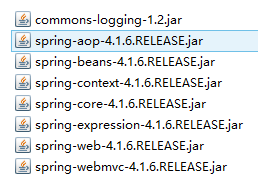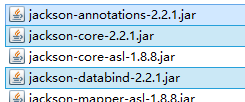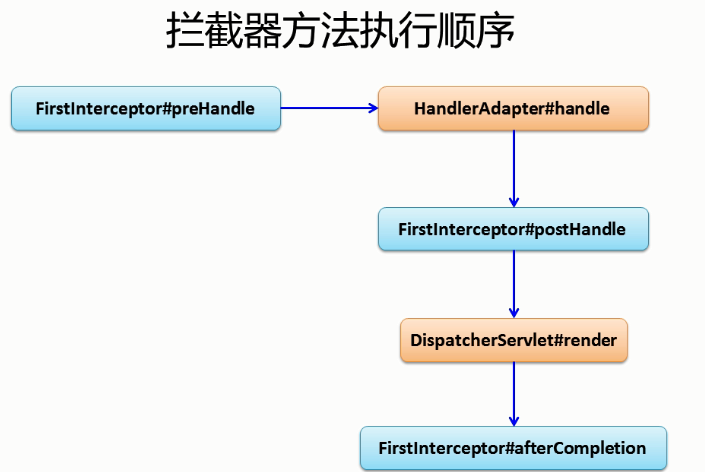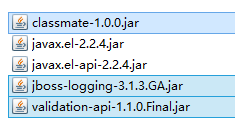史上最全的SpringMVC学习笔记
2017-08-01 00:00
423 查看
一、SpringMVC基础入门,创建一个HelloWorld程序
1,首先,导入SpringMVC需要的jar包。
2,添加Web.xml配置文件中关于SpringMVC的配置
<!--configure the setting of springmvcDispatcherServlet and configure the mapping--> <servlet> <servlet-name>springmvc</servlet-name> <servlet-class>org.springframework.web.servlet.DispatcherServlet</servlet-class> <init-param> <param-name>contextConfigLocation</param-name> <param-value>classpath:springmvc-servlet.xml</param-value> </init-param> <!-- <load-on-startup>1</load-on-startup> --> </servlet> <servlet-mapping> <servlet-name>springmvc</servlet-name> <url-pattern>/</url-pattern> </servlet-mapping>
3,在src下添加springmvc-servlet.xml配置文件
<?xml version="1.0" encoding="UTF-8"?> <beans xmlns="http://www.springframework.org/schema/beans" xmlns:xsi="http://www.w3.org/2001/XMLSchema-instance" xmlns:context="http://www.springframework.org/schema/context" xmlns:mvc="http://www.springframework.org/schema/mvc" xsi:schemaLocation="http://www.springframework.org/schema/beans http://www.springframework.org/schema/beans/spring-beans.xsd http://www.springframework.org/schema/context http://www.springframework.org/schema/context/spring-context-4.1.xsd http://www.springframework.org/schema/mvc http://www.springframework.org/schema/mvc/spring-mvc-4.1.xsd"> <!-- scan the package and the sub package --> <context:component-scan base-package="test.SpringMVC" /> <!-- don't handle the static resource --> <mvc:default-servlet-handler /> <!-- if you use annotation you must configure following setting --> <mvc:annotation-driven /> <!-- configure the InternalResourceViewResolver --> <bean class="org.springframework.web.servlet.view.InternalResourceViewResolver" id="internalResourceViewResolver"> <!-- 前缀 --> <property name="prefix" value="/WEB-INF/jsp/" /> <!-- 后缀 --> <property name="suffix" value=".jsp" /> </bean> </beans>
4,在WEB-INF文件夹下创建名为jsp的文件夹,用来存放jsp试图。创建一个hello.jsp,在body中添加“Hello World”。
5,创建包及Controller,如下所示。

6,编写Controller代码
@Controller
@RequestMapping("/mvc")
public class mvcController{
@RequestMapping("/hello")
public String Hello(){
return "hello";
}
}7,启动服务器,在浏览器上输入
http://localhost:8080/项目名/mvc/hello
二、配置解析
1,Dispatcherservlet
Dispatcheerservlet是前置控制器,配置在web.xml文件中的。拦截匹配的请求,Servlet拦截匹配规则要自己定义,把拦截下来的请求,依据相应的规则分发到目标Controller来处理,是匹配spring MVC的第一步。
2,InternalResourceViewResolver
试图名称解析器
3,以上出现的注解
@Controller负责注册到一个bean到spring上下文中
@RequestMapping注解为控制器指定可以处理哪些URL请求
三、SpringMVC常用注解
@Controller负责注册一个bean到spring上下文中
@RequestMapping
注解为控制器指定可以处理哪些URL请求
@RequestBody
该注解用于读取Request请求的body部分数据,使用系统默认配置的HttpMessageConverter进行解析,然后把相应的数据绑定到要返回的对象上,再把HttpMessageConverter返回的对象数据绑定到controller中方法的参数上。
@ResponseBody
该注解用于将Controller的方法返回的对象,通过适当的HttpMessageConverter转换为指定格式后,写入到Response对象的body数据区。
@ModelAttribute
在方法定义上使用@ModelAttribute注解:Spring MVC在调用目标处理方法前,会先逐个调用在方法级上标注了@ModelAttribute的方法
在方法的“入参“前使用@ModelAttribute注解:可以从隐含对象中获取隐含的模型数据中获取对象,再将请求参数-绑定到对象中,再传入“入参”将方法“入参”对象添加到模型中。
@RequestParam
在处理方法“入参”处使用@RequestMapping可以把请求参数传递给请求方法
@PathVariable
绑定URL占位符到入参
@ExceptionHandler
注解到方法上,出现异常时会执行该方法。
@ControllerAdvice
使一个Controller成为全局的异常处理类,类中用@ExceptionHandler方法注解的方法可以处理所有Controller发生的异常。
四、自动匹配参数
//match automatically
@RequestMapping("/person")
public String toPerson(String name, double age){
System.out.println(name+ " " +age);
return "hello";
}五、自动装箱
1,编写一个Person实体类package test.SpringMVC.model;
public class Person {
private String name;
private int age;
public String getName() {
return name;
}
public void setName(String name) {
this.name = name;
}
public int getAge() {
return age;
}
public void setAge(int age) {
this.age = age;
}
}2,在Controller里面编写方法
//boxing automatically
@RequestMapping("/person1")
public String toPerson(Person p){
System.out.println(p.getName()+" "+p.getAge());
return "hello";
}六,使用InitBinder来处理Date类型的参数
//the parameter was converted in initBinder
@RequestMapping("/date")
public String date(Date date){
System.out.println(date);
return "hello";
}
//At the time of initialization,convert the type "String" to type "date"
@InitBinder
public void initBinder(ServletRequestDataBinder binder){
binder.registerCustomEditor(Date.class, new CustomDateEditor(new SimpleDateFormat("yyyy-MM-dd"), true));
}七、向前台传递参数
//pass the parameters to front-end
@RequestMapping("/show")
public String showPerson(Map<String, Object> map){
Person p = new Person();
map.put("p", p);
p.setAge(20);
p.setName("jayjay");
return "show";
}前台可以在Request域中取到“p”
八、使用Ajax调用
//pass the parameters to font-end using ajax
@RequestMapping("/getPerson")
public void getPerson(String name. PrintWriter pw){
pw.write("hello,"+ name);
}
@RequestMapping("/name")
public String sayHello(){
return "name";
}前台用下面的jquery代码调用:
$(function(){
$("#btn").click(function(){
$.post("mvc/getPerson",
{name:$("#name").val()},
function(data){
alert(data)
});
});
});九、在Controller中使用redirect方式处理请求
//redirect
@RequestMapping("/redirect")
public String redirect(){
return "redirect:hello";
}十、文件上传
1、需要导入两个jar包
2、在SpringMVC配置文件中加入
<!-- upload settings --> <bean id="multipartResolver" class="org.springframework.web.multipart.commons.CommonsMultipartResolver"> <property name="maxUploadSize" value="102400000"> </property> </bean>
3、方法代码
@RequestMapping(value="upload",method=RequestMethod.POST)
public String upload(HttpServletRequest req) throws Exception{
MultipartHttpServletRequest mreq = (MultiparHttpServletRequest)req;
MultipartFile file = mreq.getFile("file");
String fileName = file.getOriginalFilename();
SimpleDateFormat sdf = new SimpleDateFormat("yyyyMMddHHmmsss");
FileOutputStream fos = new FileOutputStream(req.getSession().getServletContent().getRealPath("/")+
"upload/"+sdf.format(new Date())+fileName.substring(fileName.lastIndexOf('.')));
fos.write(file.getBytes());
fos.flush();
fos.close();
return "hello";
}4、前台form表单
<form acti="mvc/upload" method="post" enctype="multipart/from-data"> <input type="file" name="file"><br> <input type="submit" value="submit"> </form>
十一、使用@RequestParam注解指定参数的name
@Controller
@RequestMapping("/test")
public class mvcController1{
@RequestMapping(value="/param")
public String testRequestParam(@RequestParam(value="id") Integer id,@RequestParam(value="name") String name){
System.out.println(id+" "+name);
return "/hello";
}
}十二、RESTFul风格的SpringMVC
1、RestController@Controller
@RequestMapping("/rest")
public class RestController{
@RequestMapping(value="user/{id}", method=RequestMethod.GET)
pulic String get(@PathVariable("id") Integer id){
System.out.println("get"+id);
return "/hello";
}
@RequestMapping(value="/user/{id}", method=RequestMethod.POST)
public String post(@PathVariable("id") Integer id){
System.out.println("post"+id);
return "/hello";
}
@RequestMapping(value="/user/{id}", method=RequestMethod.PUT)
public String put(@PathVariable("id") Integer id){
System.out.println("put"+id);
return "/hello";
}
@RequestMapping(value="/user/{id}", method=RequestMethod.DELETE)
public String delete(@PathVariable("id") Integer id){
System.out.println("delete"+id);
return "/hello";
}
}2、form表单发送put和delete请求
在web.xml中配置
<!-- configure the HiddenHttpMethodFilter,convert the post method to put or delete --> <filter> <filter-name>HiddenHttpMethodFilter</filter-name> <filter-class>org.springframework.web.filter.HiddenHttpMethodFilter </filter-class> </filter> <filter-mapping> <filter-name>HiddenHttpMethodFilter</filter-name> <url-pattern>/*</url-pattern> </filter-mapping>
在前台可以用以下代码产生请求
<form action="rest/user/1" method="post"> <input type="hidden" name="_method" value="PUT"> <input type="submit" value="put"> </form> <form action="rest/user/1" method="post"> <input type="submit" value="post"> </form> <form action="rest/user/1" method="get"> <input type="submit" value="get"> </form> <form action="rest/user/1" method="post"> <input type="hidden" name="_method" value="DELETE"> <input type="submit" value="delete"> </form>
十三、返回json格式的字符串
1、导入以下jar包
2、方法代码
@Controller
@RequestMapping("/json")
public class jsonController{
@ResponseBody
@RequestMapping("/user")
public User get(){
User u = new User();
u.setId();
u.setName("jayjay");
u.setBirth(new Date());
return u;
}
}十四、异常的处理
1、处理局部异常(Controller内)@ExceptionHandler
public ModelAndView exceptionHandler(Exception ex){
ModelAndView mv =new ModelAndView("error");
mv.addObject("exception", ex);
System.out.println("in testExceptionHandler");
return mv;
}
@RequestMapping("/error")
public String error(){
int i = 5/0;
return "hello"
}2、处理全局异常(所有Controller)
@ControllerAdvice
public class testControllerAdvice{
@ExceptionHandler
public ModelAndView exceptionHandler(Exception ex){
ModelAndView mv = new ModelAndView("error");
mv.addObject("exception", ex);
System.out.println("in testControllerAdvice");
return mv;
}
}3、另一种处理全局异常的方法
在SpringMVC配置文件中去配置
<!-- configure SimpleMappingExceptionResolver --> <bean class="org.springframework.web.servlet.handler.SimpleMappingExceptionResolver"> <property name="exceptionMappings"> <props> <prop key="java.lang.ArithmeticException">error</prop> </props> </property> </bean>
error是出现错误的页面
十五、设置一个自定义拦截器
1、创建一个MyInterceptor类,并实现HandlerInterceptor接口public class MyIntercptor implements HandlerInterceptor{
@Override
public void afterCompletion(HttpServletRequest arg0, HttpServletResponse arg1, Object arg2, Exception arg3) throws Exception{
System.out.println("afterCompletion");
}
@Override
public void postHandle(HttpServletRequest arg0, HttpServletResponse arg1, Object arg2, ModelAndView arg3) throws Exception{
System.out.println("postHandle");
}
@Override
public boolean preHandle(HttpServletRequest arg0, HttpServletResponse arg1, Object arg2) throws Exception {
System.out.println("preHandle");
return true;
}
}2、在SpringMVC的配置文件中配置
<!-- interceptor setting --> <mvc:interceptors> <mvc:interceptor> <mvc:mapping path="/mvc/**" /> <bean class="test.SpringMVC.Interceptor.MyInterceptor"></bean> </mvc:interceptor> </mvc:interceptors>
3、拦截器执行顺序

十六、表单的验证(使用Hibernate-validate)及国际化
1、导入Hibernate-validate需要的jar包
(未选中不用导入)

2、编写实体类User并加上验证注解
public class User {
public int getId() {
return id;
}
public void setId(int id) {
this.id = id;
}
public String getName() {
return name;
}
public void setName(String name) {
this.name = name;
}
public Date getBirth() {
return birth;
}
public void setBirth(Date birth) {
this.birth = birth;
}
@Override
public String toString() {
return "User [id=" + id + ", name=" + name + ", birth=" + birth + "]";
}
private int id;
@NotEmpty
private String name;
@Past
@DateTimeFormat(pattern = "yyyy-MM-dd")
private Date birth;
}PS:@Post表示时间必须是一个过去值
3、在jsp中使用SpringMVC的form表单
<form:form action="form/add" method="post" modelAttribute="user"> id:<form:input path="id"/> <form:errors path="id"/><br> name:<form:input path="name"/> <form:errors path="name"/><br> birth:<form:input path="birth"/> <form:errors path="birth"/> <input type="submit" value="submit"> </form:form>
ps:path对应name
4、Controller中的代码
@Controller
@RequestMapping("/form")
public class formController {
@RequestMapping(value = "/add", method = RequestMethod.POST)
public String add(@Valid User u, BindingResult br) {
if (br.getErrorCount() > 0) {
return "addUser";
}
return "showUser";
}
@RequestMapping(value = "/add", method = RequestMethod.GET)
public String add(Map<String, Object> map) {
map.put("user", new User());
return "addUser";
}
}ps:
因为jsp中使用了modelAttribute属性,所以必须在request域中有一个“user”
@Valid表示按照实体上标记的注解验证参数
返回到原页面错误信息回显,表单也会回显
5、错误信息自定义
在src目录下添加locale.properties
NotEmpty.user.name=name can't not be empty Past.user.birth=birth should be a past value DateTimeFormat.user.birth=the format of input is wrong typeMismatch.user.birth=the format of input is wrong typeMismatch.user.id=the format of input is wrong
在SpringMVC配置文件中配置
<!-- configure the locale resource --> <bean id="messageSource" class="org.springframework.context.support.ResourceBundleMessageSource"> <property name="basename" value="locale"> </property> </bean>
相关文章推荐
- 最全SpringMVC学习笔记
- springmvc 学习笔记最全整理
- SpringMVC学习笔记(史上最全)
- 史上最全的SpringMVC学习笔记
- 史上最全的SpringMVC学习笔记(慕课网)
- 史上最全的SpringMVC学习笔记
- 史上最全的SpringMVC学习笔记
- 史上最全的SpringMVC学习笔记
- 史上最全的SpringMVC学习笔记
- Spring学习笔记-C5-SpringMVC起步
- springmvc学习笔记(22)-springmvc开发小结
- 【SpringMVC注解开发】validation校验-商品修改校验 ---SpringMVC学习笔记(六)
- [SpringMVC]SpringMVC学习笔记一: springmvc原理及实例解析.
- springmvc学习笔记--ueditor和springmvc的集成
- SpringMVC学习笔记(5):绑定数据(3)
- SpringMVC 学习笔记3 - 数据校验 & 编码过滤器
- springmvc学习笔记--支持文件上传
- ★SpringMVC学习笔记(1) 总记 学习资料
- SpringMVC学习笔记(2) 框架配置+HelloWorld(注解版)
- springmvc学习笔记——ModelAttribute
